Refurbishing a Japanese Maple - the "Hedge Cutting Method"
+18
MartinSweeney
adam1234
wabashene
cbobgo
fiona
Neli
Sam Ogranaja
Xavier de Lapeyre
lennard
shane martin
Andrew Legg
Brett Simon
JMcCoy
Todd Ellis
MrFancyPlants
mambo
gman
Walter Pall
22 posters
Page 1 of 3
Page 1 of 3 • 1, 2, 3 
 Refurbishing a Japanese Maple - the "Hedge Cutting Method"
Refurbishing a Japanese Maple - the "Hedge Cutting Method"
translated from German into English by
Michael Eckardt, President
Kitchener-Waterloo Bonsai Society
Kitchener, Ontario, Canada
Refurbishing a Japanese maple - the "hedge cutting method"
by Walter Pall
walter-pall.de
Every bonsai book describes how to work on deciduous trees to obtain the best possible ramification. All books recommend pinching. That means that immediately after the first bud break, the new shoots are pinched back to one or two buds, and that shoots that don’t grow suitably, are removed. The stated goal is to avoid long internodes and to force the tree to produce visibly smaller buds and tinier leaves with its second flush. With that, the tree is said to reach a fine ramification over many years.
Truth be told, a tree is badly weakened by the removal of the early new growth. As a consequence, it can only build weak “starvation” buds, which indeed will grow smaller shoots. This second flush is then clipped off again, and the tree is weakened even more. Eventually, they tree will become so weak that it might die.
According to my observation, this is a very questionable horticultural practice. This method only works to maintain a finished tree for some time. Eventually it will be so weak that one has to bring it back to health by encouraging strong shoot growth. To pinch a tree during its developmental phase is pointless any way. How is it going to grow, how is it to back bud, if it doesn’t have any strength? I have seen a whole lot of trees that were run down in this way.
How did this misinformation arise? Well, a few decades ago when the first bonsai trees were brought to the West, the purchasers asked how they should care for these trees. The answer was given so that no mistakes could be made. It was assumed that the owners wanted to keep the trees in the state in which they purchased them. The pinching was recommended because it is useful for trees that are ‘finished’ and ready for exhibition or sale. Nobody thought at that time that the Westerners would ever be able to develop bonsai themselves.
In the developmental phase, the goal is clearly to improve the tree. The trunk and the branches must be thickened, pruning wounds must close and the tree is to develop so many new shoots that one has a choice of useful branches. The nebari should also improve significantly. At this stage, the immediate image is secondary to the future beauty. That is why leaves can be large and the tree can look ugly for the longest time. To achieve these goals, the tree needs as much excess energy as possible which it can only obtain through the photosynthetic activity of as many leaves as possible. If exactly those sources of energy are removed too early, then the tree can’t develop. In the worst case, it dies a slow death.
Well, it happens that most of our bonsai are not ‘finished’ trees, but that they are likely in an early state of development and we want to take them further. Even imported tree that look pretty good have to be developed further. Therefore it is important to know the steps to develop trees successfully.
For decades I have been using a method successfully which is pretty much the opposite of the normally recommended approach. You can look at my picture gallery to get an idea if my method works, or if it harms the trees as many people think. All my broadleaved trees - even the most valuable and best known - have been treated this way for decades.
The following example discussing the restoration of a Japanese maple is valid for many broadleaved species. To begin, the tree has to grow as much as possible to have as many leaves as possible that, in turn, develop the energy that ends up in new buds and new growth. If the first flush in spring is allowed to grow freely, then the shoots grow very long. After about six weeks they harden off. The numerous leaves produce lots of energy in the form of carbohydrates that moves downwards through the branches and is deposited in the branches, the trunk, and finally the roots. The result is that branches and trunk thicken, that the surface roots - the nebari - also thicken, and that the roots grow strongly. At the same time, many new visible and dormant buds develop. The entire system “tree” is strengthened and it has good reserves for any setbacks. A radical cutback is such a setback.
In Central European climate about six to eight weeks after the first flush, in our area from the middle of May to the beginning of June, the tree is then cut back with big sheers to its previous silhouette. It is irrelevant where exactly it is being cut, or if any leaves are cut. This actually ought to occur as a partial leave pruning will allow light and air into the crown of the tree. All other growth inside the silhouette is not touched but strengthened with this method. And the tree is strongly encouraged to bud out again. Many dormant buds react to this radical cutback and break, even on old wood. The tree experiences the radical cut back as a trauma and over-reacts because it can mobilize much stored energy. It produces visibly more buds and activates dormant buds than it otherwise would. Exactly like after trimming a hedge. A hedge keeps getting denser if it is cut properly. Excessively long internodes tend to grow at the end of new shoots and they will be cut off with this method. This method, therefore, doesn’t create the feared long internodes. Even the largest leaves grow at the end of the new shoots and are removed completely.
The second growth is then left until early August when it is also cut off completely. The beginning of August is an important time in Central Europe. Any later and the new shoots may not harden off in time for winter. Usually, the tree needs six to eight weeks to the beginning of October to harden off. Afterwards, not much grows. It can lead to big problems for the tree when it is cut after the beginning of August as green branches will not survive the winter.
From the beginning of October to the next March, the crown can be cut again. During its dormancy the tree will not be encouraged to bud out again. When the leaves are off, one can finally see what was produced over the summer. The entire crown has become much denser, and there is much that needs work. Many branch stumps are created that must be removed now. The same with dead branches or parts of branches. But there are so many shoots that one can chose with which to work - the others can be removed completely. Sometimes you even have the problem of having too many branches to chose from. Most of the little branches will be cut back to one bud (opposite budding trees like maples) or two buds (alternate budding trees like hornbeams). In some areas where the crown needs developing less is removed. As a result of this work the tree will look quite beautiful. At this point, you can also recognize which branches should be changed in their position. They can the be wired the traditional way, or moved with the help of guy wires.
In addition to the ‘hedge cutting method’ you can use sacrifice branches in special situations. When a branch or trunk need thickening in comparison to others, just leave a few branches grow during the entire growth period. They can grow to one meter or more. The rest of the tree is treated as described. This way, the branches and the trunk beneath the sacrifice branch will thicken and the nebari will strengthen. This method is especially useful to improve the lower branches that normally don’t thicken because of the apical dominance of most trees. The example tree, however, is just the opposite - it is basally dominant. It’s upper branches are weaker and they are specifically strengthened with sacrifice branches.
Broadleaved trees can be markedly improved when this method is consistently applied over a number of years as the featured maple demonstrates. When it finally is ‘finished’ one can pinch again, especially when it is to be shown at an exhibition. At this point it will be showable for a couple of years - the goal for all bonsai enthusiasts. But eventually, the tree will deteriorate and has to be strengthened again with strong, new growth.
The disadvantage of my method is that the tree can be shown only rarely over many years. There’s always something that isn’t quite right: too many branches, guy wires, a altogether neglected appearance. Temporary beauty is deliberately sacrificed for future quality. But top trees can only be created this way. If you don’t want his, if you are not ready to pay the price for quality, then you have to live with the fact that your trees don’t improve, and even deteriorates over time. But you can enjoy looking at their beauty for some time. And this is exactly the advice we received from Japanese gardeners decades ago.

Picture 1: 2008-05:
The tree arrived in my garden in this state. The previous owner had
kept it in Akadama mush and thought that he would automatically improve the tree by
pinching. The crown is much too wide and flat and the leaves hide poorly structured
branches. Many branches are dead. The Nebari could be much better and the maple is
planted too high in its pot.

Picture 2: 2008-05:
The much too dense substrate lead to severe damage in the upper parts of the crown. Many small
leaved varieties of Acer palmatum are basally dominant which means that the lower branches tend
to be strong while the upper branches might be abandoned. This is exactly the opposite of most
other trees. The picture likely shows the rear of the tree, although the nebari appears to look
better than from the front.

Picture 3: 2008-05:
The first step was a strong cut back. The silhouette is deliberately kept a little smaller than
ideal to allow room for additional growth. If you were cut back to the ideal shape, then the
crown would soon grow too large and would have to be cut back hard again.
Michael Eckardt, President
Kitchener-Waterloo Bonsai Society
Kitchener, Ontario, Canada
Refurbishing a Japanese maple - the "hedge cutting method"
by Walter Pall
walter-pall.de
Every bonsai book describes how to work on deciduous trees to obtain the best possible ramification. All books recommend pinching. That means that immediately after the first bud break, the new shoots are pinched back to one or two buds, and that shoots that don’t grow suitably, are removed. The stated goal is to avoid long internodes and to force the tree to produce visibly smaller buds and tinier leaves with its second flush. With that, the tree is said to reach a fine ramification over many years.
Truth be told, a tree is badly weakened by the removal of the early new growth. As a consequence, it can only build weak “starvation” buds, which indeed will grow smaller shoots. This second flush is then clipped off again, and the tree is weakened even more. Eventually, they tree will become so weak that it might die.
According to my observation, this is a very questionable horticultural practice. This method only works to maintain a finished tree for some time. Eventually it will be so weak that one has to bring it back to health by encouraging strong shoot growth. To pinch a tree during its developmental phase is pointless any way. How is it going to grow, how is it to back bud, if it doesn’t have any strength? I have seen a whole lot of trees that were run down in this way.
How did this misinformation arise? Well, a few decades ago when the first bonsai trees were brought to the West, the purchasers asked how they should care for these trees. The answer was given so that no mistakes could be made. It was assumed that the owners wanted to keep the trees in the state in which they purchased them. The pinching was recommended because it is useful for trees that are ‘finished’ and ready for exhibition or sale. Nobody thought at that time that the Westerners would ever be able to develop bonsai themselves.
In the developmental phase, the goal is clearly to improve the tree. The trunk and the branches must be thickened, pruning wounds must close and the tree is to develop so many new shoots that one has a choice of useful branches. The nebari should also improve significantly. At this stage, the immediate image is secondary to the future beauty. That is why leaves can be large and the tree can look ugly for the longest time. To achieve these goals, the tree needs as much excess energy as possible which it can only obtain through the photosynthetic activity of as many leaves as possible. If exactly those sources of energy are removed too early, then the tree can’t develop. In the worst case, it dies a slow death.
Well, it happens that most of our bonsai are not ‘finished’ trees, but that they are likely in an early state of development and we want to take them further. Even imported tree that look pretty good have to be developed further. Therefore it is important to know the steps to develop trees successfully.
For decades I have been using a method successfully which is pretty much the opposite of the normally recommended approach. You can look at my picture gallery to get an idea if my method works, or if it harms the trees as many people think. All my broadleaved trees - even the most valuable and best known - have been treated this way for decades.
The following example discussing the restoration of a Japanese maple is valid for many broadleaved species. To begin, the tree has to grow as much as possible to have as many leaves as possible that, in turn, develop the energy that ends up in new buds and new growth. If the first flush in spring is allowed to grow freely, then the shoots grow very long. After about six weeks they harden off. The numerous leaves produce lots of energy in the form of carbohydrates that moves downwards through the branches and is deposited in the branches, the trunk, and finally the roots. The result is that branches and trunk thicken, that the surface roots - the nebari - also thicken, and that the roots grow strongly. At the same time, many new visible and dormant buds develop. The entire system “tree” is strengthened and it has good reserves for any setbacks. A radical cutback is such a setback.
In Central European climate about six to eight weeks after the first flush, in our area from the middle of May to the beginning of June, the tree is then cut back with big sheers to its previous silhouette. It is irrelevant where exactly it is being cut, or if any leaves are cut. This actually ought to occur as a partial leave pruning will allow light and air into the crown of the tree. All other growth inside the silhouette is not touched but strengthened with this method. And the tree is strongly encouraged to bud out again. Many dormant buds react to this radical cutback and break, even on old wood. The tree experiences the radical cut back as a trauma and over-reacts because it can mobilize much stored energy. It produces visibly more buds and activates dormant buds than it otherwise would. Exactly like after trimming a hedge. A hedge keeps getting denser if it is cut properly. Excessively long internodes tend to grow at the end of new shoots and they will be cut off with this method. This method, therefore, doesn’t create the feared long internodes. Even the largest leaves grow at the end of the new shoots and are removed completely.
The second growth is then left until early August when it is also cut off completely. The beginning of August is an important time in Central Europe. Any later and the new shoots may not harden off in time for winter. Usually, the tree needs six to eight weeks to the beginning of October to harden off. Afterwards, not much grows. It can lead to big problems for the tree when it is cut after the beginning of August as green branches will not survive the winter.
From the beginning of October to the next March, the crown can be cut again. During its dormancy the tree will not be encouraged to bud out again. When the leaves are off, one can finally see what was produced over the summer. The entire crown has become much denser, and there is much that needs work. Many branch stumps are created that must be removed now. The same with dead branches or parts of branches. But there are so many shoots that one can chose with which to work - the others can be removed completely. Sometimes you even have the problem of having too many branches to chose from. Most of the little branches will be cut back to one bud (opposite budding trees like maples) or two buds (alternate budding trees like hornbeams). In some areas where the crown needs developing less is removed. As a result of this work the tree will look quite beautiful. At this point, you can also recognize which branches should be changed in their position. They can the be wired the traditional way, or moved with the help of guy wires.
In addition to the ‘hedge cutting method’ you can use sacrifice branches in special situations. When a branch or trunk need thickening in comparison to others, just leave a few branches grow during the entire growth period. They can grow to one meter or more. The rest of the tree is treated as described. This way, the branches and the trunk beneath the sacrifice branch will thicken and the nebari will strengthen. This method is especially useful to improve the lower branches that normally don’t thicken because of the apical dominance of most trees. The example tree, however, is just the opposite - it is basally dominant. It’s upper branches are weaker and they are specifically strengthened with sacrifice branches.
Broadleaved trees can be markedly improved when this method is consistently applied over a number of years as the featured maple demonstrates. When it finally is ‘finished’ one can pinch again, especially when it is to be shown at an exhibition. At this point it will be showable for a couple of years - the goal for all bonsai enthusiasts. But eventually, the tree will deteriorate and has to be strengthened again with strong, new growth.
The disadvantage of my method is that the tree can be shown only rarely over many years. There’s always something that isn’t quite right: too many branches, guy wires, a altogether neglected appearance. Temporary beauty is deliberately sacrificed for future quality. But top trees can only be created this way. If you don’t want his, if you are not ready to pay the price for quality, then you have to live with the fact that your trees don’t improve, and even deteriorates over time. But you can enjoy looking at their beauty for some time. And this is exactly the advice we received from Japanese gardeners decades ago.

Picture 1: 2008-05:
The tree arrived in my garden in this state. The previous owner had
kept it in Akadama mush and thought that he would automatically improve the tree by
pinching. The crown is much too wide and flat and the leaves hide poorly structured
branches. Many branches are dead. The Nebari could be much better and the maple is
planted too high in its pot.

Picture 2: 2008-05:
The much too dense substrate lead to severe damage in the upper parts of the crown. Many small
leaved varieties of Acer palmatum are basally dominant which means that the lower branches tend
to be strong while the upper branches might be abandoned. This is exactly the opposite of most
other trees. The picture likely shows the rear of the tree, although the nebari appears to look
better than from the front.

Picture 3: 2008-05:
The first step was a strong cut back. The silhouette is deliberately kept a little smaller than
ideal to allow room for additional growth. If you were cut back to the ideal shape, then the
crown would soon grow too large and would have to be cut back hard again.
Last edited by Walter Pall on Wed Feb 13, 2013 9:44 am; edited 2 times in total

Walter Pall- Member
 Re: Refurbishing a Japanese Maple - the "Hedge Cutting Method"
Re: Refurbishing a Japanese Maple - the "Hedge Cutting Method"

Picture 4: 2008-05:
I would have loved to free the tree from the compacted Akadama, but it was clearly too late
in the year. It would have been possible in the fall, but it wasn’t that critical. In any case,
the nebari was worked out strongly. It already was a big improvement. The tree is not
positioned well in its pot.

Picture 5: 2008-07:
Because this variety is basally dominant, the top has to be strengthened by allowing some
selected shoots to grow freely. The center trunk ought to be the biggest and thickest. If it is
not worked on actively, the exact opposite happens. Especially this trunk must be
strengthened by using sacrifice branches; otherwise it could even die.

Picture 6: 2009-01:
A deciduous tree can be much better evaluated without its leaves. It is now apparent that
the center tree ought to be much thicker and somewhat higher. The previous owner didn’t
achieve much by many years of pinching. It looks rather poorly developed. The pot by
Bryan Albright seems over powering.

Picture 7: 2009-04:
The maple was repotted into a better pot from Japan. Most of the compacted Akadama
was removed. The root ball was heavily reduced and the roots loosened up. For the
substrate, many materials are suitable that don’t break down in cold and moisture. In this
case I used expanded clay with 15 % rough peat. This allows heavy watering and feeding without
having to worry.

Picture 8: 2009-11:
The development in two growth periods is already well advanced. The branches are better
ramified, the main trunk is stronger, and the nebari is improving constantly. The crown is
still a little too flat. Now is the best time for detailed work on the crown.

Picture 9: 2009-11:
The sacrifice branches in the crown must not be allowed to become too thick, otherwise
they will develop ugly scars. That is why they are removed entirely and regrown in the next summer.
The crown is worked on with a pair of pointy sharp scissors. Dead branchlets and branch stumps
are removed. The branches are cut back to one or two buds, and those that grow into the wrong
direction must be removed completely.
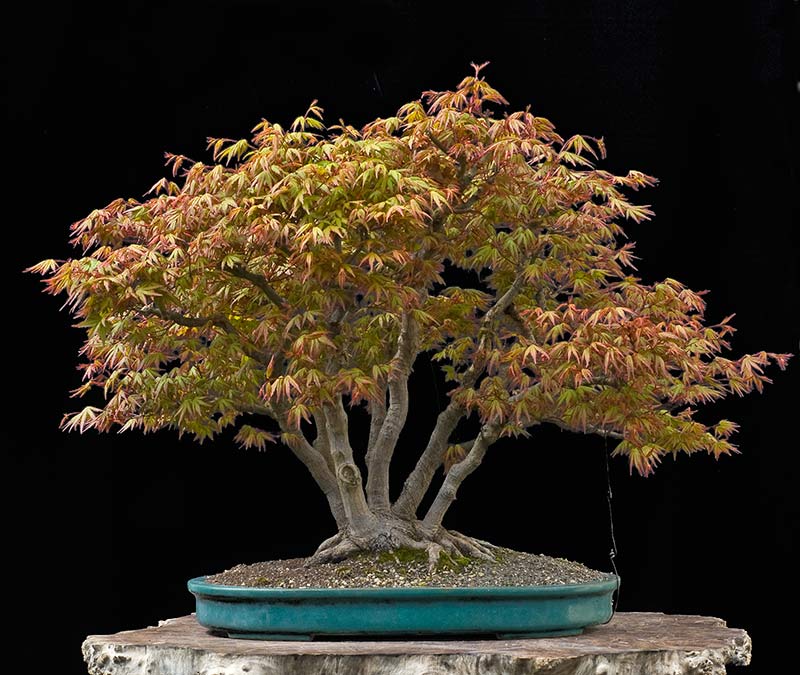
Picture 10: 2010-03:
Two years after the restoration, the tree is looking pretty good. Japanese maples are very
handsome trees that in each season look different but always lovely.
This is especially the case in spring. Despite this, the crown must be developed further -
contentment is the end of Art.

Picture 11: 2010-10:
The tree looks very good in the fall too. Yet this is not yet the time to exhibit the tree. The
trunks must continue to be corrected. With strong guy wires they are forced into new
positions. It is advantageous to exaggerate somewhat because the tree will spring back a
little anyway.

Picture 12: 2010-11:
After the guy wires were removed and the crown was carefully cleaned out, the tree was -
for the first time - truly ready for exhibition. Of course, there are still problems.
The large wound on the front trunk is ugly to look at at. But there’s nothing to be
done except to wait for many years. The middle trunk is now clearly the highest and
the crown isn’t entirely flat and even.

Picture 13: 2011-03:
It is tempting to see this lovely new growth as a signal that the tree is ‘finished’ and to
enjoy its beauty from now on. But that would be a compromise over the long term. The
main trunk must continue to grow strongly, the wounds must heal, and the nebari can be
improved much. But something like that doesn’t happen on its own - it requires a lot of
work.

Walter Pall- Member
 Re: Refurbishing a Japanese Maple - the "Hedge Cutting Method"
Re: Refurbishing a Japanese Maple - the "Hedge Cutting Method"

Picture 14: 2011-04:
Here you can clearly see that pinching was completely avoided. The tree was allowed to
grow out fully. Six or more weeks later, the new growth has become fairly long. Now, the
crown is cut quickly with a hedge pruner. In deed, it is like pruning a hedge. The exact cut
is not important, and it even doesn’t matter if leaves are partially cut. Only the long term
success counts.
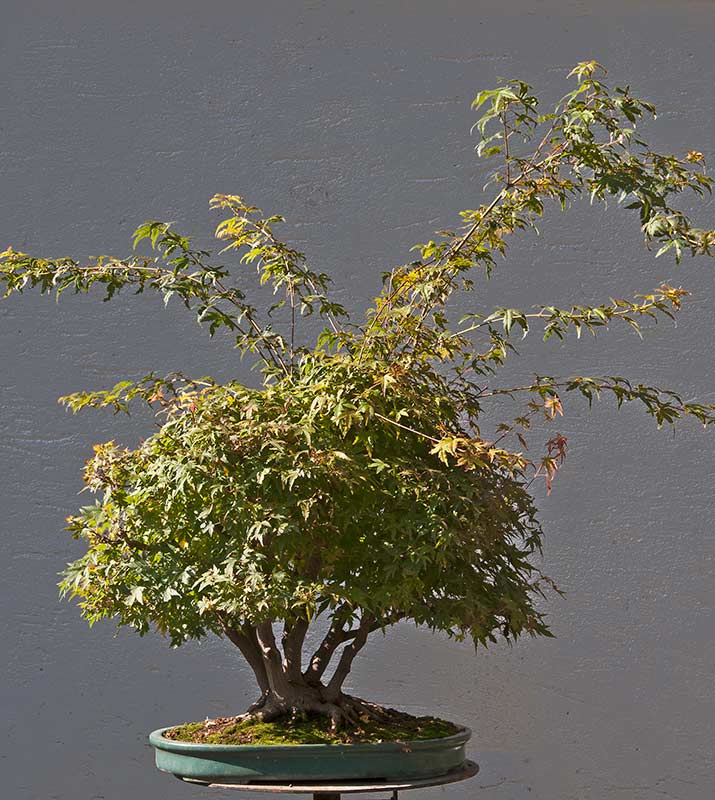
Picture 15: 2011-10:
During the summer, the tree was cut twice with the hedge pruners. Selected sacrifice
branches were allowed to grow unrestricted. Momentary beauty is sacrificed for long term
quality. It will be a few more years like this. This is the only way to turn an average tree
into a top bonsai.

Picture 16: 2011-10:
In the fall, the tree’s crown is cut again with the hedge pruners, even the sacrifice
branches. As long as there a leaves on the branches it doesn’t make much sense to look
too closely where and what is being cut. That will happen in a few weeks when the tree is
bare. The picture shows real hedge pruners.

Picture 17: 2011-10:
The result doesn’t look too bad at all. But the tree was designed for its winter view. As long
as the leaves are on the tree, you can’t really see it. The crown is nothing but a big ball of
leaves. Amateurs usually prefer that a tree looks good in the summer, but pros prefer the winter
image. A compromise isn’t always helpful and usually leads to weaknesses over all.

Picture 18: 2011-11:
Four weeks later, the leaves are removed. The crown is now carefully pruned. At this point
you can only guess at where the sacrifice branches once grew; the wounds are growing
out well. Two of the trunks in the group must still be forced into a better position.
Unfortunately this is only possible with ugly guy wires.

Picture 19: 2012-04:
This view is reward for all the work. The guy wires are only removed for the pictures, and
then reattached afterward. Because the rest is almost perfect, the big ugly wound in the
front tree is now very apparent. Although it has healed noticeable since the maple was
able to built much energy though it lush growth. The main trunk could also become much
stronger yet - but this is whining at a high level.

Picture 20: 2012-12:
It is November and the leaves are removed again. One can clearly see that some
branches are too long and a few ugly branch stumps were left over. The tree is now
cleaned out with a pair of pointy, sharp scissors. In a few years, one should get the feeling
that Mother Nature is the best artist, and that she creates the best crowns. The hand of
man will eventually become invisible, even though he did so much.
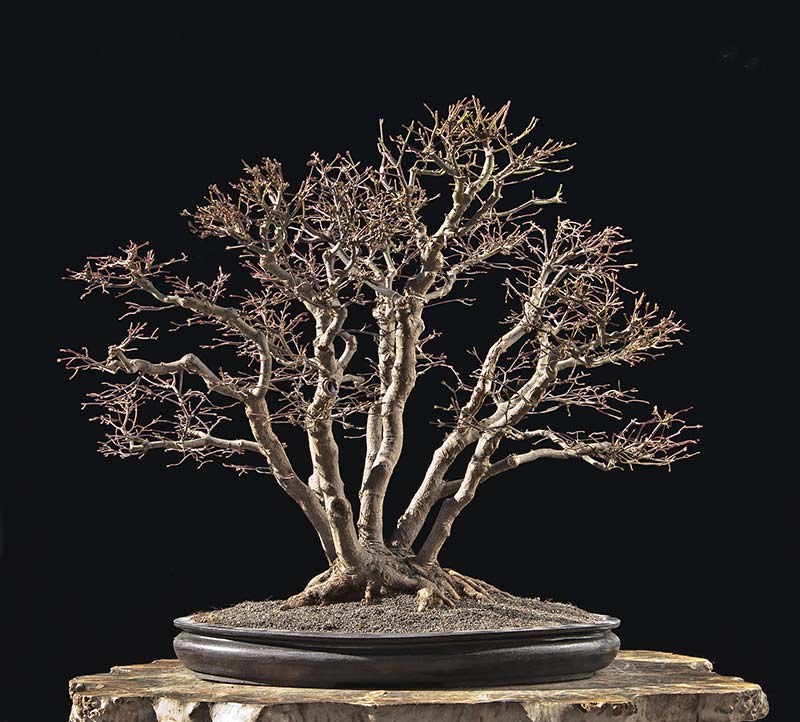
Picture 21: 2012-12:
Slowly the tree is turning out as it should. The crown looks balanced and the entire group
looks as if it had gracefully grown on its own. This, perhaps, gives the viewer the idea that
something like this is result of a hands-off approach. The development so far, however,
teaches the opposite: only through strong and very focused interventions over many years
can such a natural shape be developed.

Picture 22: 2013-02:
The tree was repotted into a very suitable pot by Walter Venne from Germany. The results of the
development thus far are quite presentable. But is is by far not the end of the
development. Much has changed in five growth periods, yet the work continues as before.
In another five years the tree will be better again. The drawback, however, will be that he tree
is not really presentable during much of that time.

Walter Pall- Member
 Re: Refurbishing a Japanese Maple - the "Hedge Cutting Method"
Re: Refurbishing a Japanese Maple - the "Hedge Cutting Method"
Walter,
Thanks you so much for taking the time to provide us with such an excellent post.
Cheers Graham
Thanks you so much for taking the time to provide us with such an excellent post.
Cheers Graham
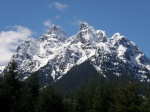
gman- Member
 Re: Refurbishing a Japanese Maple - the "Hedge Cutting Method"
Re: Refurbishing a Japanese Maple - the "Hedge Cutting Method"
Hi Walter,
Thanks for sharing your experiences with this tree.
There was an article in Bonsai Pasion regarding the pinching (or not pinching) of deciduous trees a few years ago. It covered the method used by the Kyukaen nursery, using a famous broom style Zelkova that was owned by President Yoshida as an example. This article avoided bud pinching, rather allowing the shoots to grow and then cutting back at a later date.
I am one of those who in the past has pinched buds as they emerged year after year and for some years wondered why I had so much die back in winter. So I can testify that over pinching does not work in the long term.
In that article, they only pruned once during the growing season. The article also stressed the importance of fertilizing at the right moment and in the correct quantities. They fertilized after pinching back and from the end of summer through to the autumn. The sign that too much fertilizer was being used was no branch die back over winter, continuous new shoots and over-thickening of branches. The sign of too little was die back of too many branches in winter. The ideal was that just a few branches should die back.
Thanks for sharing your experiences with this tree.
There was an article in Bonsai Pasion regarding the pinching (or not pinching) of deciduous trees a few years ago. It covered the method used by the Kyukaen nursery, using a famous broom style Zelkova that was owned by President Yoshida as an example. This article avoided bud pinching, rather allowing the shoots to grow and then cutting back at a later date.
I am one of those who in the past has pinched buds as they emerged year after year and for some years wondered why I had so much die back in winter. So I can testify that over pinching does not work in the long term.
In that article, they only pruned once during the growing season. The article also stressed the importance of fertilizing at the right moment and in the correct quantities. They fertilized after pinching back and from the end of summer through to the autumn. The sign that too much fertilizer was being used was no branch die back over winter, continuous new shoots and over-thickening of branches. The sign of too little was die back of too many branches in winter. The ideal was that just a few branches should die back.
mambo- Member
 Re: Refurbishing a Japanese Maple - the "Hedge Cutting Method"
Re: Refurbishing a Japanese Maple - the "Hedge Cutting Method"
Thanks for sharing Walter. This is a paradigm shift in the making. I've heard that many have recently rejected pinching when it comes to Junipers and now deciduous.

MrFancyPlants- Member
 Re: Refurbishing a Japanese Maple - the "Hedge Cutting Method"
Re: Refurbishing a Japanese Maple - the "Hedge Cutting Method"
I always learn from Walter Pall. Thank you for this post!

Todd Ellis- Member
 Re: Refurbishing a Japanese Maple - the "Hedge Cutting Method"
Re: Refurbishing a Japanese Maple - the "Hedge Cutting Method"
Excellent, excellent post on broadleaf tree care and the next level work on ramification. Strong trees = healthier trees = more beautiful trees! Thank you for dispensing with some of those old Bonsai styling myths! 
Last edited by JMcCoy on Fri Feb 15, 2013 2:57 pm; edited 1 time in total
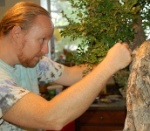
JMcCoy- Member
 Re: Refurbishing a Japanese Maple - the "Hedge Cutting Method"
Re: Refurbishing a Japanese Maple - the "Hedge Cutting Method"
Walter, excellent.
I am a horticulturalist who has a love of Bonsai. For a while now i have been having this same conversation with growers who "pinch away" the strength of their trees. Trying to explain that the tree is losing its vigour by constant pinching was difficult. You have summed it up with actual proof. Very nicely done.
One question, do you think that the same applies to evergreen trees, in my case Olives? I am just referring to the health of the tree, not the growing method.
Regards
Brett
I am a horticulturalist who has a love of Bonsai. For a while now i have been having this same conversation with growers who "pinch away" the strength of their trees. Trying to explain that the tree is losing its vigour by constant pinching was difficult. You have summed it up with actual proof. Very nicely done.
One question, do you think that the same applies to evergreen trees, in my case Olives? I am just referring to the health of the tree, not the growing method.
Regards
Brett
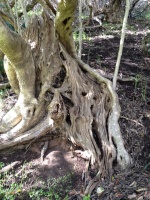
Brett Simon- Member
 Re: Refurbishing a Japanese Maple - the "Hedge Cutting Method"
Re: Refurbishing a Japanese Maple - the "Hedge Cutting Method"
Brett,
i speak of 'broadleaved' trees and not 'deciduous' trees. In the English language 'deciduous' is treated as if it were a botanical big family. Really 'broadleaved' is the better botanical term. It includes all trees which are not 'conifers' (except gingko). All broadleaved trees in development have similar properties. Why should there be a difference between deciduous and evergreens when they are closely related. All sub-tropical and tropical trees in development should be treated as I describe. The difference is only that there is no winter break. So I suggest you just cut them back severely every two to three months and let them grow in between. This is not bonsai wisdom, it is just general gardeners wisdom applied to bonsai.
i speak of 'broadleaved' trees and not 'deciduous' trees. In the English language 'deciduous' is treated as if it were a botanical big family. Really 'broadleaved' is the better botanical term. It includes all trees which are not 'conifers' (except gingko). All broadleaved trees in development have similar properties. Why should there be a difference between deciduous and evergreens when they are closely related. All sub-tropical and tropical trees in development should be treated as I describe. The difference is only that there is no winter break. So I suggest you just cut them back severely every two to three months and let them grow in between. This is not bonsai wisdom, it is just general gardeners wisdom applied to bonsai.
Last edited by Walter Pall on Fri Feb 15, 2013 9:45 am; edited 1 time in total

Walter Pall- Member
 Re: Refurbishing a Japanese Maple - the "Hedge Cutting Method"
Re: Refurbishing a Japanese Maple - the "Hedge Cutting Method"
Thanks Walter
Exactly as i thought.
Regards
Brett
Exactly as i thought.
Regards
Brett

Brett Simon- Member
 Re: Refurbishing a Japanese Maple - the "Hedge Cutting Method"
Re: Refurbishing a Japanese Maple - the "Hedge Cutting Method"
Hi Walter,
Out of curiosity, do you have a collections of smaller trees as well. From what I've seen of your trees and the trees in which you take an interest on the web, they seem to be the bigger trees. Would you say that the technique discussed above applies to mame and shohin trees as well?
Cheers,
Andrew
Out of curiosity, do you have a collections of smaller trees as well. From what I've seen of your trees and the trees in which you take an interest on the web, they seem to be the bigger trees. Would you say that the technique discussed above applies to mame and shohin trees as well?
Cheers,
Andrew
Andrew Legg- Member
 Re: Refurbishing a Japanese Maple - the "Hedge Cutting Method"
Re: Refurbishing a Japanese Maple - the "Hedge Cutting Method"
Andrew,
I have about 100 shohin trees in my collection and another 200 for trade and sale, more than most folks. I use exactly the same methods on them.
I have about 100 shohin trees in my collection and another 200 for trade and sale, more than most folks. I use exactly the same methods on them.
Last edited by Walter Pall on Mon Feb 18, 2013 11:58 am; edited 1 time in total

Walter Pall- Member
 Re: Refurbishing a Japanese Maple - the "Hedge Cutting Method"
Re: Refurbishing a Japanese Maple - the "Hedge Cutting Method"
Walter Pall wrote:Andrew,
I have about 100 shohin trees in my collection and another 200 for trade ans sale, more than most folks. I use exactly the same methods on them.
Interesting - thanks Walter.
Andrew Legg- Member
 Re: Refurbishing a Japanese Maple - the "Hedge Cutting Method"
Re: Refurbishing a Japanese Maple - the "Hedge Cutting Method"
Walter,Walter Pall wrote:Andrew,
I have about 100 shohin trees in my collection and another 200 for trade and sale, more than most folks. I use exactly the same methods on them.
After reading this information, I feel like I had been driving in the rain with out my windscreen wipers on, and now the windscreen is clear as a bell. Thankyou for this. I used this method many years ago and was told I was using the technique of a novice landscaper, so I switched back to the more ''traditional'' method. For many years now, I have followed the proverbial pinching regime.... particularly on my junipers, but this season I chose NOT to pinch at all, but rather allow the trees free reign. I have also changed to "full sun" positioning for 90% of my trees. My location here in Australia, has a sub tropical climate and can reach 35-40 deg. C in Summer. The result has been remarkable healthy compact growth. I grow a lot of Trident Maple, and all but a few are also grown in full sun. I ALWAYS grew my trees under 50% shadecloth, but since changing my substrate as well to a much more free draining less organic mix, and a regular fert. program, my trees have never looked better.

Last edited by shane martin on Thu Feb 21, 2013 3:52 am; edited 1 time in total (Reason for editing : typo)
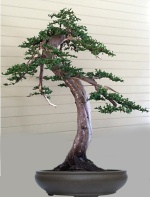
shane martin- Member
 Re: Refurbishing a Japanese Maple - the "Hedge Cutting Method"
Re: Refurbishing a Japanese Maple - the "Hedge Cutting Method"
Walter Pall wrote:
Picture 16: 2011-10:
In the fall, the tree’s crown is cut again with the hedge pruners, even the sacrifice
branches. As long as there a leaves on the branches it doesn’t make much sense to look
too closely where and what is being cut. That will happen in a few weeks when the tree is
bare. The picture shows real hedge pruners.
Hi Walter.
Hope everything is better now.
May I ask why you cut of the sacrifice branches and excessive growth in Autumn and not when the tree is resting in winter? Will it not encourage latent buds that will not harden off before winter?
Lennard

lennard- Member
 Re: Refurbishing a Japanese Maple - the "Hedge Cutting Method"
Re: Refurbishing a Japanese Maple - the "Hedge Cutting Method"
Lennard,
It is eaxtly explained in the article. Please read again.
It is eaxtly explained in the article. Please read again.

Walter Pall- Member
 Re: Refurbishing a Japanese Maple - the "Hedge Cutting Method"
Re: Refurbishing a Japanese Maple - the "Hedge Cutting Method"
Hi Walter,
Hope you're recovering well.
@Lennard, for your question: May I ask why you cut of the sacrifice branches and excessive growth in Autumn and not when the tree is resting in winter? Will it not encourage latent buds that will not harden off before winter?
I think its this part:
I guess you must adapt to your climate and adapt the process based on when new shoots will harden off in your climate.
For me august is end of winter, start of summer.
Hope you're recovering well.
@Lennard, for your question: May I ask why you cut of the sacrifice branches and excessive growth in Autumn and not when the tree is resting in winter? Will it not encourage latent buds that will not harden off before winter?
I think its this part:
...
The second growth is then left until early August when it is also cut off completely. The beginning of August is an important time in Central Europe. Any later and the new shoots may not harden off in time for winter. Usually, the tree needs six to eight weeks to the beginning of October to harden off. Afterwards, not much grows. It can lead to big problems for the tree when it is cut after the beginning of August as green branches will not survive the winter.
...
I guess you must adapt to your climate and adapt the process based on when new shoots will harden off in your climate.
For me august is end of winter, start of summer.
Last edited by Xavier de Lapeyre on Fri Mar 22, 2013 4:45 am; edited 2 times in total (Reason for editing : Posted prematurely)

Xavier de Lapeyre- Member
 Cutting back
Cutting back
I think I did not understand it because our autumn here in Rustenburg, South Africa is very short. The Maple trees here are just shutting down growth(stopped sending out new growth but the leaves are still green) even with temperatures of 23 degrees Celsius at night going up in daytime to 32 degrees Celsius. The trees will only start to change color in early June and bud out again in September. If I cut back all the strong growths now I will probably get new weaker buds growing?
If I read the growing season of Maples correctly it seems that dormancy/not sending out new growth is triggered by daylight length and not temperature so much?
I do have one that I can cut back to see how it reacts in my conditions.
Thanks for the replies Walter and Xavier.
Lennard
If I read the growing season of Maples correctly it seems that dormancy/not sending out new growth is triggered by daylight length and not temperature so much?
I do have one that I can cut back to see how it reacts in my conditions.
Thanks for the replies Walter and Xavier.
Lennard

lennard- Member
 Re: Refurbishing a Japanese Maple - the "Hedge Cutting Method"
Re: Refurbishing a Japanese Maple - the "Hedge Cutting Method"
Hey Walter (and whoever else feels like taking a stab at the answer),
Do you treat newly repotted trees in this way or do you let them establish for a period of time?
Thanks for your time!!!
Sam
Do you treat newly repotted trees in this way or do you let them establish for a period of time?
Thanks for your time!!!
Sam

Sam Ogranaja- Member
 Re: Refurbishing a Japanese Maple - the "Hedge Cutting Method"
Re: Refurbishing a Japanese Maple - the "Hedge Cutting Method"
Walter answered my question on his blog.
His response was classic Walter: "All the same"
Happy growing folks!!!
His response was classic Walter: "All the same"
Happy growing folks!!!

Sam Ogranaja- Member
 Re: Refurbishing a Japanese Maple - the "Hedge Cutting Method"
Re: Refurbishing a Japanese Maple - the "Hedge Cutting Method"
Sam, also recently repotted trees. If they don't grow vigorously I let them grow freely longer. To prune a weak tree would mean to weaken it even further.
The key to this method is NOT to prune with a hedge cutter. The key is to strenghen trees by letting them grow much longer than most bonsai practitioners would. You can afterwards cut them with anything you like, even with a hedge pruner.
Judge by long term results and not by uneducated prejudices.
The key to this method is NOT to prune with a hedge cutter. The key is to strenghen trees by letting them grow much longer than most bonsai practitioners would. You can afterwards cut them with anything you like, even with a hedge pruner.
Judge by long term results and not by uneducated prejudices.

Walter Pall- Member
 Re: Refurbishing a Japanese Maple - the "Hedge Cutting Method"
Re: Refurbishing a Japanese Maple - the "Hedge Cutting Method"
I am just a newbie. So I wanted to understand this method better. So i asked WP on his blog some questions...it seems I upset him since he told me to ask this questions on a forum, and kept my post for a day but the following day was deleted. I did not mean to offend him, just wanted to understand. I have lots of respect for his experience and knowledge.
So I found this topic, and since it is a forum I would like to ask, so I get a better answer and understand it better.
I leave in Africa...I have growth almost the whole year...in cold climates You have much less growth...so you try to achieve, as much as you can during the warmer month.
So my question is that.
If you just cut with the hedge pruners, any how, without looking where you cut slightly less than the final shape, You are bound to have some short and after that some long internodes...If you repeat that 3 times, you will have an alternation of : first short, then some long internodes, then again some short after the second cut and again some long ones...and then again some short ones after the third cut which is supposed to be the final one for the year in cold climates...Then when the tree is resting you go in and cut to the first two short internodes....so your result for the year is two short internodes....of growth.
I like what he is saying that branches should be left to grow long in order to strengthen the health of the tree, what I dont understand is why the hedge pruners.
I dont have 4000 or even 100 bonsai...and I enjoy trimming my bonsai...why not trim each brunch after allowing it to grow the same length like with the hedge method, carefully after the short (lets say 2 ), internodes, and then grow it in the same manner, and repeat with careful cutting. I am not in a hurry, and I like it.
If each time I cut carefully, at the end of the season I will have 6 internodes and all of them short, and not only two like with the hedge method. I can understand that this method is good for people with so many bonsai since it is efficient and fast, but how it is good for me?.
What is it here that I dont understand? What are the advantages of the hedge pruners for me?
I recently bought some gardenias...they were all trimmed at the nursery like a hedge...By the time I removed all the knobs created by 3-4 branches coming from the same spot, and untangled all the mess, there was nothing left. I can show you pictures to see.
So please explain to me where I am going wrong with my thinking....after all I am just a newbie, and maybe I dont understand something here.
So I found this topic, and since it is a forum I would like to ask, so I get a better answer and understand it better.
I leave in Africa...I have growth almost the whole year...in cold climates You have much less growth...so you try to achieve, as much as you can during the warmer month.
So my question is that.
If you just cut with the hedge pruners, any how, without looking where you cut slightly less than the final shape, You are bound to have some short and after that some long internodes...If you repeat that 3 times, you will have an alternation of : first short, then some long internodes, then again some short after the second cut and again some long ones...and then again some short ones after the third cut which is supposed to be the final one for the year in cold climates...Then when the tree is resting you go in and cut to the first two short internodes....so your result for the year is two short internodes....of growth.
I like what he is saying that branches should be left to grow long in order to strengthen the health of the tree, what I dont understand is why the hedge pruners.
I dont have 4000 or even 100 bonsai...and I enjoy trimming my bonsai...why not trim each brunch after allowing it to grow the same length like with the hedge method, carefully after the short (lets say 2 ), internodes, and then grow it in the same manner, and repeat with careful cutting. I am not in a hurry, and I like it.
If each time I cut carefully, at the end of the season I will have 6 internodes and all of them short, and not only two like with the hedge method. I can understand that this method is good for people with so many bonsai since it is efficient and fast, but how it is good for me?.
What is it here that I dont understand? What are the advantages of the hedge pruners for me?
I recently bought some gardenias...they were all trimmed at the nursery like a hedge...By the time I removed all the knobs created by 3-4 branches coming from the same spot, and untangled all the mess, there was nothing left. I can show you pictures to see.
So please explain to me where I am going wrong with my thinking....after all I am just a newbie, and maybe I dont understand something here.

Neli- Member
 Re: Refurbishing a Japanese Maple - the "Hedge Cutting Method"
Re: Refurbishing a Japanese Maple - the "Hedge Cutting Method"
This Japanese maple was exhibited on Kokufu Ten and on Noelanders Trophy, it costs about a yearly salary of a regular worker. There are many things people say abut me, but very rarely they say that I am stupid. Does anyone think that I prune this maple like a hedge to save time? Would I not use the traditional method if I though that it is better for the development of this tree?
The last image is what you get for having an ugly tree throughout the vegetation period. I fully understand that most folks would hate to see this in their garden. But then they just will not develop their maples and most will go downhill.
These gardening measures can ONLY be judged by long term results.
The main thing is health of tree, then quality of long term outcome, then time takes for outcome, then cost and time it takes to work .
Neli, you picked the least important argument and write as if I did this all just for saving time and otherwise there are only disadvantages. The opposite is true. I only do this for the health of the tree and long term quality improvement.
The disadvantages that you state are simply not present, just look at how close I cut. If you hate hedge pruners, take small scissors and achieve the same result in many hours.
My blog is not a forum. I am NOT interested in discussing things there much. I show what I do for free to the world and otherwise wish to be left alone by and large.







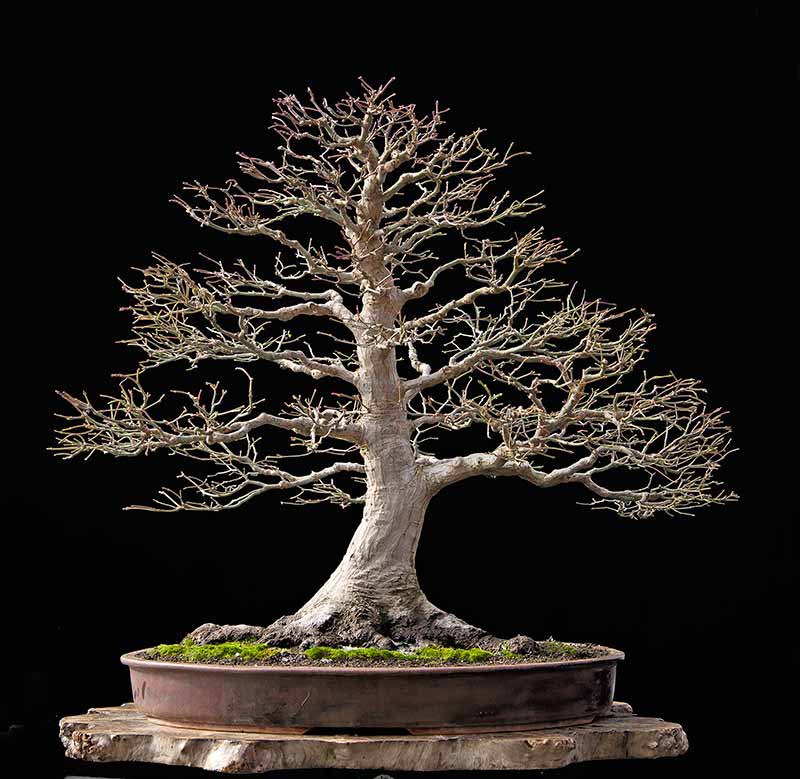
The last image is what you get for having an ugly tree throughout the vegetation period. I fully understand that most folks would hate to see this in their garden. But then they just will not develop their maples and most will go downhill.
These gardening measures can ONLY be judged by long term results.
The main thing is health of tree, then quality of long term outcome, then time takes for outcome, then cost and time it takes to work .
Neli, you picked the least important argument and write as if I did this all just for saving time and otherwise there are only disadvantages. The opposite is true. I only do this for the health of the tree and long term quality improvement.
The disadvantages that you state are simply not present, just look at how close I cut. If you hate hedge pruners, take small scissors and achieve the same result in many hours.
My blog is not a forum. I am NOT interested in discussing things there much. I show what I do for free to the world and otherwise wish to be left alone by and large.









Walter Pall- Member
 Re: Refurbishing a Japanese Maple - the "Hedge Cutting Method"
Re: Refurbishing a Japanese Maple - the "Hedge Cutting Method"
This is how I found out about the hedge cutting method:
Many years ago I got several batches of trees, one very similar maples, the other elms, and then some cherries. I picked the best ones of the batch and declared them part of my collection. I planted them into good pots and cared for them for many years according to what I had learned is the 'right' way.
The other ones were for sale. I thought highly of their quality and put price tags on them which were probably too high. They did not sell for a number of years.
One day in November when the leaves were off I finally had a close look at the sale plants and found something amazing. They were much better developed than the ones in my collection. Their trunks were about twice as thick, the nebari was a lot better. The ramification was much better. The only thing that bothered me was that there were way too many branches looking untidy. So I took one after the other and edited the crown. I had the greatest problem: there were so many branches and buds that it was hard to choose. Anyway, in the end my sales trees were MUCH better then the ones in my collection.
What had happened? Well, Every spring I started working on my trees, first with the best ones, of course. After a few weeks I had done abut 200 trees. I never came to the sales lot for lack of time. So I let these grow freely for a few weeks. When they were so big that they dried out very quickly for having too much foliage I took a large hedge pruner and cut them back ruthlessly. Two to three months later I did the same thing. And then in late fall when there was not the danger of the trees throwing shoots anymore. In between I used my aggressive watering and feeding regime, feeding MUCH more than most people would.
And then I decided to do this with all trees on a regular basis. From then on the quality of my collection suddenly rose significantly and continues to do so.
Many years ago I got several batches of trees, one very similar maples, the other elms, and then some cherries. I picked the best ones of the batch and declared them part of my collection. I planted them into good pots and cared for them for many years according to what I had learned is the 'right' way.
The other ones were for sale. I thought highly of their quality and put price tags on them which were probably too high. They did not sell for a number of years.
One day in November when the leaves were off I finally had a close look at the sale plants and found something amazing. They were much better developed than the ones in my collection. Their trunks were about twice as thick, the nebari was a lot better. The ramification was much better. The only thing that bothered me was that there were way too many branches looking untidy. So I took one after the other and edited the crown. I had the greatest problem: there were so many branches and buds that it was hard to choose. Anyway, in the end my sales trees were MUCH better then the ones in my collection.
What had happened? Well, Every spring I started working on my trees, first with the best ones, of course. After a few weeks I had done abut 200 trees. I never came to the sales lot for lack of time. So I let these grow freely for a few weeks. When they were so big that they dried out very quickly for having too much foliage I took a large hedge pruner and cut them back ruthlessly. Two to three months later I did the same thing. And then in late fall when there was not the danger of the trees throwing shoots anymore. In between I used my aggressive watering and feeding regime, feeding MUCH more than most people would.
And then I decided to do this with all trees on a regular basis. From then on the quality of my collection suddenly rose significantly and continues to do so.

Walter Pall- Member
Page 1 of 3 • 1, 2, 3 
 Similar topics
Similar topics» Hedge method by Walter pall.
» Copper beech using the hedge cutter method i guess.
» Acer campestre - Hedge Maple Question
» Hedge Maple - Acer campestre Leaves
» Trident maple root cutting?
» Copper beech using the hedge cutter method i guess.
» Acer campestre - Hedge Maple Question
» Hedge Maple - Acer campestre Leaves
» Trident maple root cutting?
Page 1 of 3
Permissions in this forum:
You cannot reply to topics in this forum






